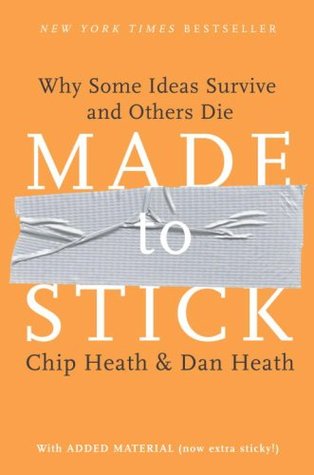 Made to Stick: Why Some Ideas Survive and Others Die by Chip Heath and Dan Heath
Made to Stick: Why Some Ideas Survive and Others Die by Chip Heath and Dan Heath
My rating: 4 of 5 stars
The main thing about this book are the stories within it for which the book is packed. Here I just include the important parts but I do recommend the book for the stories which will make the content here actually stick. If the content does not stick then there was no point. Additionally speaking abilities does not tie with people being able to recollect the content.
Sticky = understandable, memorable and effective in changing thoughts or behaviour
As such for your presentation you need people to:
- Pay attention
- Understand
- Remember
- Agree/Believe
- Care
- Be able to act on it
From research creativity is found to have a formula which can be learnt, using the template means that your message will more likely be memorable. Using the six principles:
- Simplicity
- Unexpectedness (helps people pay attention)
- Concreteness (helps people understand and remember)
- Credibility (helps people Agree/Believe)
- Emotions (helps people care)
- Stories (helps people be able to act on it)
Alongside the six principles there is one recurring warning – the curse of knowledge – the fact is is not possible to unknow what you already know, where as what you know no one else does (else there would be little point in telling them). The tapping a tune game is a way to highlight to people about the impact that they know the answer and others don’t.
Simplicity = the core of your message + compactness.
- Commander’s intent – prefixing all messages with the intent of a mission, this has a much more power full meaning than a command, e.g. “capture a hill” – why? where as “secure the convoy as it passes by” gives more flexibility while still achieving the same aim.
- Burying the lead – by putting in so much other stuff that the actual meaning is lost.
- Inverted pyramid– start with the most important points.
- If you say three things you say nothing – work out what your point is and keep to just one
- Decision paralysis – by having a clear simple message helps people make decisions
- Using whats there – build on things which people already know, this does simplify things at the expense of accuracy but conversely accuracy does not stick where as derivatives do
Unexpected
- Breaking the guessing machine – people’s brains work in autopilot – for your idea to stick you need to kick the brain out of autopilot and something unexpected will do that, it will make the brain pay attention.
- Gap theory of curiosity – people want to know things, they can’t be left with a half finished problem. As such presenting a mystery, a gap, will keep people listening till the end however the gap needs to be a suitable size as too big won’t interest people.
Concreteness
- Make it real – abstract concepts people struggle with where as naming things, e.g. the Mount Hamilton Wilderness, can greatly increase people connection.
- Concrete is memorable – e.g. bicycle is more memorable than e.g. justice
- Curse of knowledge – it is difficult to unlearn what you know and to put yourself in the shoes of your listener
- Ferraris go to Disney World – talking about concrete ideas is one thing but making them in another and vastly compelling way for people to see what you are presenting
Credible
- Antiauthority – someone who is the opposite of your message to desaude e.g. smoking by a smoker
- The power of detail – people are more convinced someone is credible when there is more detail in their descriptions
- Statistics – these can help prove your point but large abstract numbers do not, instead using analogies such as a large bucket of popcorn has more fat than a full day of other foods
- Fort Knox – by showing that you work in the toughest place you can win over less challenging companies
Emotional
- If I look at the one – giving a single compelling story is much more powerful than general sweeping statements, people don’t associate with groups only individuals
- Appeal to self interest – People care about themselves so what is in it for me?
- Get people to dream it – “Imagine yourself as …” drives people to action
- Aim for the top of Maslow’s hierarchy – “This bonus shows how great a job you are doing and how much you are appreciated by the company” not “This bonus will let you do home improvements”
- Association with people you respect – means your message is listened to more
- Why should someone care? – A repeat of the curse of knowledge but why is it important?
Stories
- Entertaining and instructional – If the story is entertaining and has a meaning people will enjoy and remember it
- The art of spotting – Stories happen all the time, the key is to grab them and use them
- Challenge plot – appeal to our perseverance and courage. They make us want to work harder, take on new challenges and overcome obstacles.
- Connection plot – about our relationships with other people.
- Creative plot – make us want to do something different, to be creative, to experiment with new approaches.
- Conference storybook – Capturing the stories from a conference is a great way to remember the content though the presenters might not like the effort of their learnings being lost